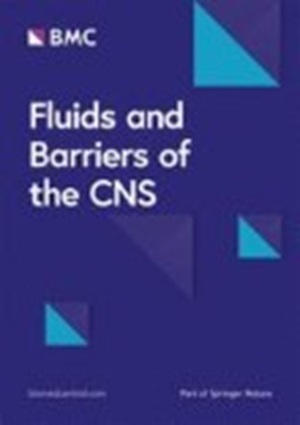Coupled pulsatile vascular and paravascular fluid dynamics in the human brain
IF 5.9
1区 医学
Q1 NEUROSCIENCES
引用次数: 0
Abstract
Cardiac pulsation propels blood through the cerebrovascular network to maintain cerebral homeostasis. The cerebrovascular network is uniquely surrounded by paravascular cerebrospinal fluid (pCSF), which plays a crucial role in waste removal, and its flow is suspected to be driven by arterial pulsations. Despite its importance, the relationship between vascular and paravascular fluid dynamics throughout the cardiac cycle remains poorly understood in humans. In this study, we developed a non-invasive neuroimaging approach to investigate the coupling between pulsatile vascular and pCSF dynamics within the subarachnoid space of the human brain. Resting-state functional MRI (fMRI) and dynamic diffusion-weighted imaging (dynDWI) were retrospectively cardiac-aligned to represent cerebral hemodynamics and pCSF motion, respectively. We measured the time between peaks (∆TTP) in $$\frac{d}{d\phi }fMRI$$ and dynDWI waveforms and measured their coupling by calculating the waveforms correlation after peak alignment (correlation at aligned peaks). We compared the ∆TTP and correlation at aligned peaks between younger [mean age: 27.9 (3.3) years, n = 9] and older adults [mean age: 70.5 (6.6) years, n = 20], and assessed their reproducibility within subjects and across different imaging protocols. Hemodynamic changes consistently precede pCSF motion. ∆TTP was significantly shorter in younger adults compared to older adults (−0.015 vs. −0.069, p < 0.05). The correlation at aligned peaks were high and did not differ between younger and older adults (0.833 vs. 0.776, p = 0.153). The ∆TTP and correlation at aligned peaks were robust across fMRI protocols (∆TTP: −0.15 vs. −0.053, p = 0.239; correlation at aligned peaks: 0.813 vs. 0.812, p = 0.985) and demonstrated good to excellent within-subject reproducibility (∆TTP: intraclass correlation coefficient = 0.36; correlation at aligned peaks: intraclass correlation coefficient = 0.89). This study proposes a non-invasive technique to evaluate vascular and paravascular fluid dynamics. Our findings reveal a consistent and robust cardiac pulsation-driven coupling between cerebral hemodynamics and pCSF dynamics in both younger and older adults.人脑中的搏动血管和血管旁流体耦合动力学
心脏搏动推动血液流经脑血管网络,以维持大脑的平衡。脑血管网络周围有独特的血管旁脑脊液(pCSF),它在清除废物方面起着至关重要的作用,其流动被怀疑是由动脉搏动驱动的。尽管其重要性不言而喻,但人类对整个心动周期中血管和血管旁液体动力学之间的关系仍然知之甚少。在这项研究中,我们开发了一种非侵入性神经成像方法来研究人脑蛛网膜下腔内血管搏动和 pCSF 动态之间的耦合关系。我们对静息态功能磁共振成像(fMRI)和动态弥散加权成像(dynDWI)进行了回溯性心脏配准,以分别表示脑血流动力学和 pCSF 运动。我们测量了 $$\frac{d}{d\phi }fMRI$$ 和 dynDWI 波形的峰值间隔时间(∆TTP),并通过计算峰值对齐后的波形相关性(峰值对齐时的相关性)来测量它们之间的耦合。我们比较了年轻人[平均年龄:27.9 (3.3)岁,n = 9]和老年人[平均年龄:70.5 (6.6)岁,n = 20]的 ∆TTP 和峰值对齐时的相关性,并评估了它们在受试者内部和不同成像方案中的可重复性。血流动力学变化始终先于 pCSF 运动。与老年人相比,年轻人的 ∆TTP 明显较短(-0.015 对 -0.069,P < 0.05)。对齐峰值的相关性很高,年轻人和老年人之间没有差异(0.833 vs. 0.776,p = 0.153)。在不同的 fMRI 方案中,对齐峰的 ∆TTP 和相关性都很稳定(∆TTP:-0.15 vs. -0.053,p = 0.239;对齐峰相关性:0.813 vs. 0.812,p = 0.985),并表现出良好至卓越的受试者内重现性(∆TTP:类内相关系数 = 0.36;对齐峰相关性:类内相关系数 = 0.89)。这项研究提出了一种评估血管和血管旁流体动力学的无创技术。我们的研究结果表明,在年轻人和老年人中,脑血流动力学和 pCSF 动力学之间存在一致且强大的心脏搏动驱动耦合。
本文章由计算机程序翻译,如有差异,请以英文原文为准。
求助全文
约1分钟内获得全文
求助全文
来源期刊

Fluids and Barriers of the CNS
Neuroscience-Developmental Neuroscience
CiteScore
10.70
自引率
8.20%
发文量
94
审稿时长
14 weeks
期刊介绍:
"Fluids and Barriers of the CNS" is a scholarly open access journal that specializes in the intricate world of the central nervous system's fluids and barriers, which are pivotal for the health and well-being of the human body. This journal is a peer-reviewed platform that welcomes research manuscripts exploring the full spectrum of CNS fluids and barriers, with a particular focus on their roles in both health and disease.
At the heart of this journal's interest is the cerebrospinal fluid (CSF), a vital fluid that circulates within the brain and spinal cord, playing a multifaceted role in the normal functioning of the brain and in various neurological conditions. The journal delves into the composition, circulation, and absorption of CSF, as well as its relationship with the parenchymal interstitial fluid and the neurovascular unit at the blood-brain barrier (BBB).
 求助内容:
求助内容: 应助结果提醒方式:
应助结果提醒方式:


